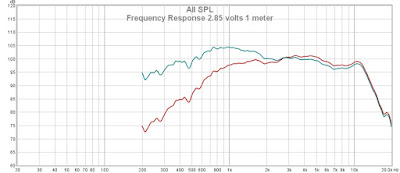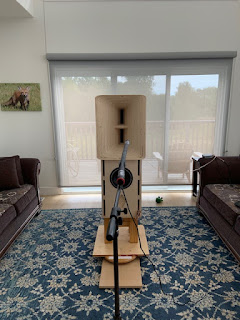This blog post features the E-250 Dual Planar Front Horn which uses two BG Neo8 Planar Transducers in a large format front horn to cover 250Hz - 20kHz. This blog post will show all acoustical measurements including for fun a direct comparison against a regular 2-way bookshelf speaker.
Design & Construction
This horn is a custom design by myself. The horn is made up of stacked layer of plywood. Each layer is finish machined in the CNC router including the four alignment dowels to fully align each layer during assembly. A 1/2" ball nose cutter surface machined the horn flare geometry for a smooth finish with minimal sanding. Following the machining process there was no visible machining marks!
The horn is 17 layers of 18mm thick baltic birch plywood (fully hardwood). There is a central phase plug to fill in the gap left between the two BG Neo8's. The phase plug serves to prevent cancellations in the high frequencies.
Acoustical Measurement
I set up as usual in my living room on my rotary table and reference measurement mic placed at 1 meter distance. I calibrated the SPL level and AC voltage for 2.83 volts to get an accurate sensitivity measurement. I will show the on axis frequency response, off-axis coloured polar maps, and a comparison against a regular bookshelf speaker, the Signet SL-16. The Signet represents what I think is a traditional 2-way bookshelf. This Canadian made speaker was likely developed at the NRC's anechoic chamber and uses high quality drivers.
| E-250 On-Axis Frequency Response |
The on-axis frequency response shows extension down to 200 Hz however there is a large hump centered around 1kHz that can easily be corrected with a LCR contour circuit in the crossover. There is no rear chamber on this horn and I suspect that the addition of the rear chamber would help bring up the region between 200Hz - 500Hz. The response in the region from 2kHz - 13kHz is very flat where it fall off sharply above 13kHz.
Adding 39uF capacitor
Inserting a 39uF capacitor achieves the follow frequency response. This would be the most basic crossover which actually creates 750Hz crossover with a 12dB/octave acoustical slope. I did not play with any more passive crossover solutions, however I can send the .FRD and .ZMA files to those interested if they would like to simulate their own crossover.
Sensitivity @ 1watt/1meter (2.83volts)
 |
| E-250 Sensitivity 1watt/1meter 2.83volts |
The horn achieves excellent sensitivity and I've overlaid with and without the 39uF capacitor.
Off-Axis Coloured Polar Map
Below are the off-axis coloured polar map response for this horn.
| Horizontal Off-Axis Coloured Polar Map |
The horn achieves the above polars with near constant directivity from 500Hz - 10kHz where it gradually narrows to around 40 degrees coverage at 13kHz. The widening above this I believe can be ignored since this is where the frequency response falls off sharply. The key observation here is the well behaved off-axis in terms of even coverage. There are no anomalies where the coverage sharply widens or narrows. This map is shown with 12dB smoothing.
Burst Decay Waterfall Plot
The horn achieves the following spectral burst decay waterfall plot which shows the amount of stored energy in the time domain. This helps highlight any serious issues with horn resonance or diffraction off the horn mouth which may causes the sound the reverse direction back down the horn. A clean burst decay plot will result in a clean sound! It's a simple as that. You want to see quick decay from the initial burst of sound.
| E-250 Burst Decay Waterfall Plot |
The above plot shows some energy from 200Hz-2kHz however this may be acoustical effects of my room. To know for sure I will need to test the horn in a larger space. Above 2kHz the horn performs extremely well with zero diaphragm breakup in the upper treble. This is where the Planar technology excels that of a compression driver. All compression drivers I've tested to date have some breakup in the upper treble.
Looking at a similar plot, REW's Spectrogram confirms a very clean result...
Adding Rear Blanket over drivers
I decided to add a blanket over the drivers to absorb the backwave. Below is the effect on the measurement...
Waterfall Decay with blanket...
| E-250 with blanket covering back of drivers |
Comparing against 2-way Bookshelf Speaker
One of the design requirements with the E-250 was to have similar coverage in the high frequencies as a regular 1" dome tweeter. To confirm this I decided to test a regular bookshelf speaker to see how the two compared in terms of upper treble 'beaming'. The speaker in question is the Signet SL-16 which features 6.5" woofer and 1" metal dome tweeter. This is a high quality speaker with very good drivers.
Frequency Response/Sensitivity
| E-250 compared against Signet Bookshelf Speaker |
Horizontal Off-Axis Coloured Polar Map
| Signet Bookshelf Speaker Horizontal Off-Axis Coloured Polar Map |
As we can see there is a significant difference with the bookshelf speaker's horizontal off-axis coverage versus the E-250 Front Horn. However I wanted to look closely at the upper treble beaming compared against the horn.
The bookshelf speaker has a slightly wider coverage pattern in the upper treble compared to the horn but there is an important distinction between the two that must be considered as well. The overall power response is the combined output of both the on-axis and off axis energy to give a summation of what you would hear in your listening room. This is where the horn would have a much more balanced sound in terms of timbre since the power response into the room would be much flatter. An easy way to tell this is to play a song with close mic vocal recording and walk out of the room. When you listen from the other room does it sound like convincing like somebody is actually in the other room singing? If it doesn't then odds are that the overall power response is not flat.
| Upper Treble coverage pattern comparison |
Burst Decay Waterfall Plot
| Signet Bookshelf Speaker Burst Decay Waterfall Plot |
The burst decay is not as clean as the E-250 horn even in the midrange and treble.
| Signet Bookshelf speaker REW Spectrogram |
The Spectrogram in REW is showing strong reflections from the room at the measurement mic location since no pattern control is achieved like the horn.
Conclusion
The ES-250 Dual Planar Front horn achieves better detail and resolution than any ribbon or planar solution that I've heard. Since the sound is coherent and point source then I noticed that I'm able to hear very deep into the music. Subtle fluctuations in various wood instruments come out clearly. Dynamics are on part with a good compression driver and yet I find the sound to be very smooth. I don't get any sense of horn 'honk' or colouration with this horn. I found that the horn mated well to the Autumn Bass Cabinet that uses the Fostex FW208HS. This 8" Fostex was able to match the resolution of the planar from 250Hz and below. I achieved a balanced sound by bi-amping with 15 watts on the horn and 100 watts on the bass. Since the woofer is only 88dB sensitive and the horn is 100dB you are able to use low power class amplification on the horn and more beefy power on the bass.
Update October 22, 2019
I was able to test the "S" version of the Neo8 and I subsequently redid the burst decay measurement. This measurement was done in my basement rec room which was cleared out of any furniture or other sources of reflection. As you can see the burst decay waterfall plot looks very clean. Please not the dB vertical scale is set to the normal 25dB.
Update October 22, 2019
I was able to test the "S" version of the Neo8 and I subsequently redid the burst decay measurement. This measurement was done in my basement rec room which was cleared out of any furniture or other sources of reflection. As you can see the burst decay waterfall plot looks very clean. Please not the dB vertical scale is set to the normal 25dB.
| Dual Neo8 Front Horn with BG Neo8S version...Burst Decay Waterfall Plot, Gated 5ms |











